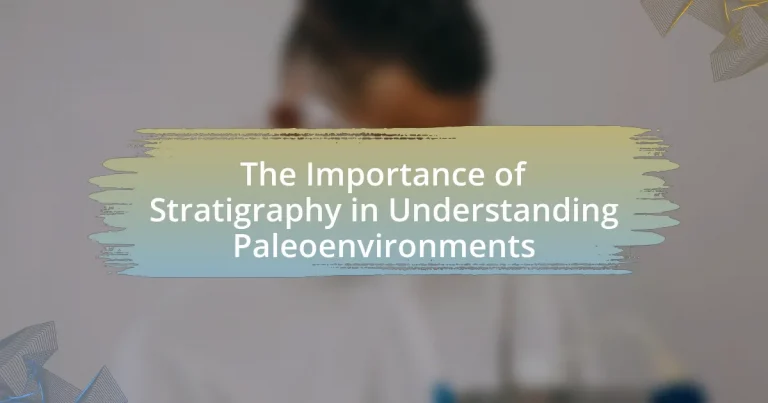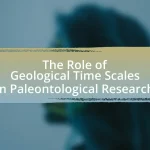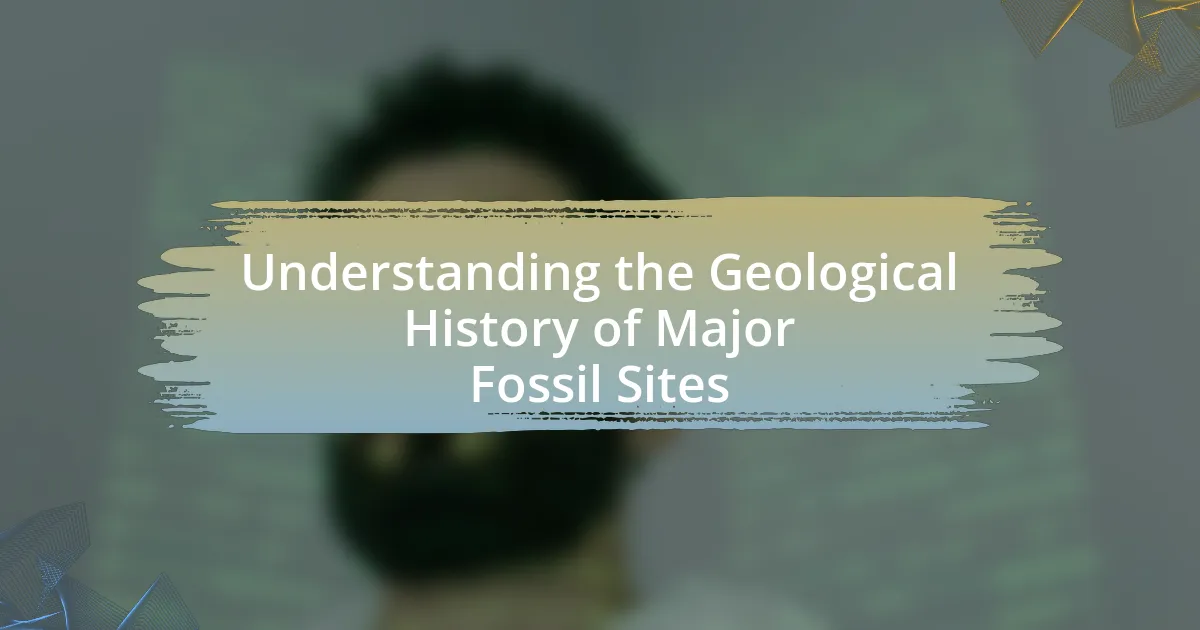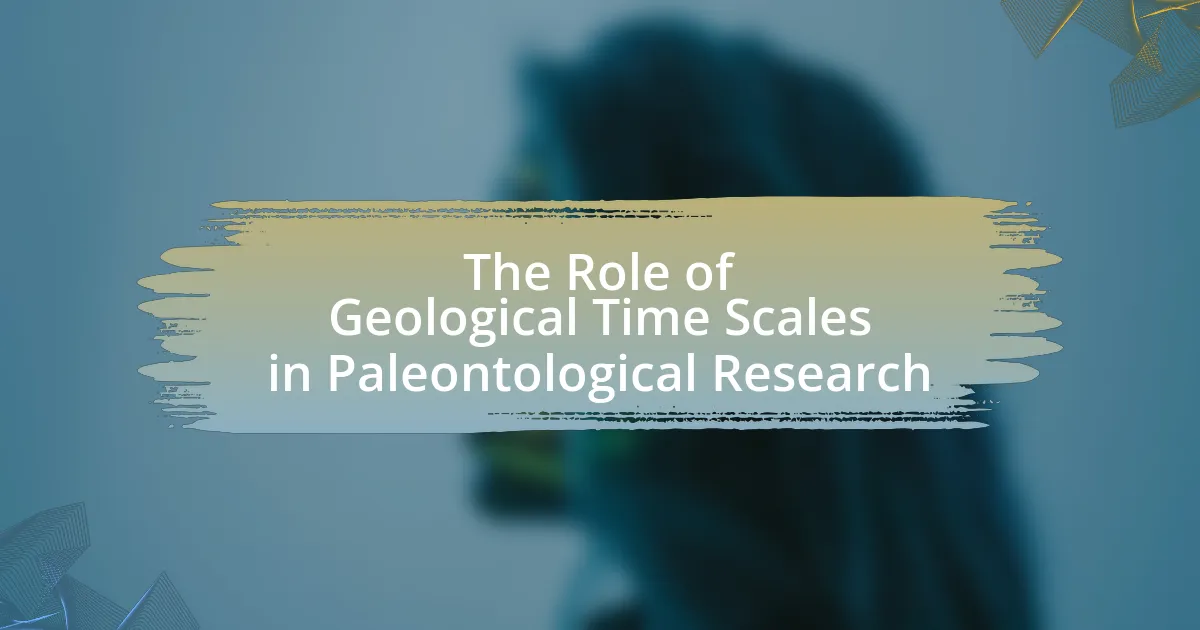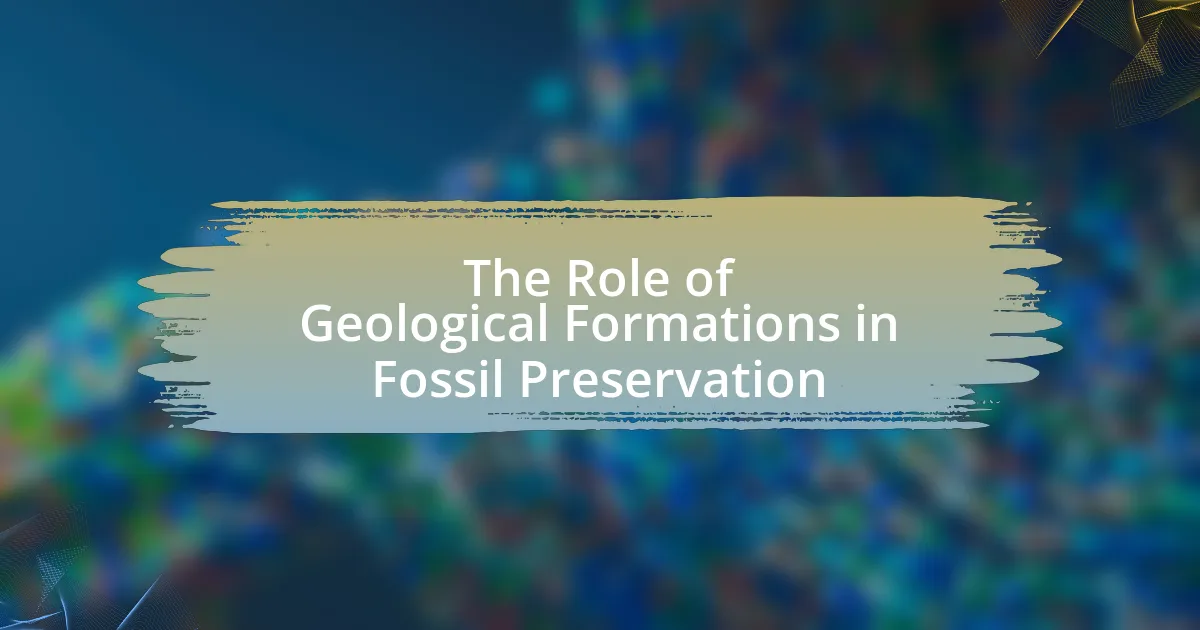Stratigraphy is a fundamental discipline in geology that plays a crucial role in understanding paleoenvironments by analyzing the relationships and sequences of sedimentary rock layers. This article explores the significance of stratigraphy in reconstructing geological history, interpreting ancient ecological conditions, and identifying fossil records. Key principles such as the Law of Superposition and methods like lithostratigraphy and biostratigraphy are discussed, highlighting their contributions to the study of past climates and environments. Additionally, the article addresses challenges faced in stratigraphic studies and the interdisciplinary connections between stratigraphy, paleontology, and climate science, emphasizing its importance in contemporary ecological research and conservation efforts.

What is the significance of stratigraphy in understanding paleoenvironments?
Stratigraphy is significant in understanding paleoenvironments because it provides a framework for interpreting the geological history and depositional processes of sedimentary layers. By analyzing the vertical and lateral relationships of rock layers, geologists can reconstruct past environments, including climate conditions, biological activity, and tectonic events. For instance, the identification of specific fossil assemblages within stratigraphic layers allows scientists to infer the ecological conditions that existed at different geological times, as demonstrated in studies of the Late Cretaceous period where marine transgressions and regressions were mapped through stratigraphic analysis. This methodical approach enables a clearer understanding of how ancient environments evolved over time, making stratigraphy a crucial tool in paleontological and geological research.
How does stratigraphy contribute to the study of ancient environments?
Stratigraphy contributes to the study of ancient environments by providing a framework for understanding the chronological sequence of geological layers and their associated depositional environments. This discipline allows researchers to interpret the history of sediment deposition, which reflects past environmental conditions such as climate, sea level changes, and biological activity. For instance, the identification of specific sediment types, like sandstone or shale, can indicate whether an area was once a river, lake, or ocean. Additionally, stratigraphic analysis often incorporates fossil records found within these layers, which serve as indicators of the types of organisms that existed at different times, further elucidating the ecological context of ancient environments.
What are the key principles of stratigraphy relevant to paleoenvironments?
The key principles of stratigraphy relevant to paleoenvironments include the Law of Superposition, the Principle of Original Horizontality, and the Principle of Lateral Continuity. The Law of Superposition states that in undisturbed sedimentary sequences, older layers are found below younger layers, which helps in reconstructing the chronological sequence of environmental changes. The Principle of Original Horizontality posits that sediments are originally deposited in horizontal layers, indicating that any tilting or folding occurred after deposition, thus providing insights into geological events affecting paleoenvironments. The Principle of Lateral Continuity asserts that layers of sediment initially extend laterally in all directions, allowing for the correlation of strata across distances, which is crucial for understanding the spatial distribution of ancient environments. These principles collectively enable geologists to interpret the geological history and environmental conditions of past eras accurately.
How do stratigraphic layers inform us about past ecological conditions?
Stratigraphic layers inform us about past ecological conditions by preserving evidence of sediment deposition, fossil content, and chemical signatures that reflect ancient environments. Each layer represents a specific time period, allowing scientists to reconstruct the ecological history by analyzing the types of sediments, the presence of particular fossils, and isotopic compositions. For instance, the presence of marine fossils in a layer indicates a past marine environment, while coal deposits suggest lush, vegetated conditions. Additionally, variations in grain size and composition can indicate changes in energy levels and climate, providing insights into how ecosystems responded to environmental shifts over time.
Why is stratigraphy considered a fundamental tool in geology?
Stratigraphy is considered a fundamental tool in geology because it provides a systematic framework for understanding the temporal and spatial relationships of rock layers. This discipline allows geologists to interpret the geological history of an area by analyzing the sequence, distribution, and age of sedimentary and volcanic deposits. For instance, the Law of Superposition, which states that in undisturbed strata, the oldest layers are at the bottom and the youngest at the top, is a key principle that aids in dating geological formations. Additionally, stratigraphy facilitates the reconstruction of past environments and climate conditions, as seen in studies of sediment cores from various locations that reveal changes in depositional environments over time.
What role does stratigraphy play in reconstructing geological history?
Stratigraphy plays a crucial role in reconstructing geological history by providing a framework for understanding the chronological sequence of rock layers and their relationships. This discipline allows geologists to interpret the temporal and spatial distribution of sedimentary deposits, which reflect past environmental conditions and events. For instance, the Law of Superposition states that in undisturbed strata, older layers are found beneath younger ones, enabling scientists to establish a timeline of geological events. Additionally, biostratigraphy, which uses fossil content to correlate and date rock layers, further enhances the understanding of historical biodiversity and ecological changes over time. These methods collectively contribute to a comprehensive reconstruction of Earth’s geological history, revealing insights into past climates, tectonic activities, and biological evolution.
How does stratigraphy aid in the identification of fossil records?
Stratigraphy aids in the identification of fossil records by providing a framework for understanding the chronological sequence of rock layers and their associated fossils. This geological discipline allows scientists to correlate layers across different locations, establishing a timeline for when specific organisms existed. For instance, the principle of superposition states that in undisturbed sedimentary sequences, older layers are found beneath younger ones, enabling paleontologists to date fossils relative to one another. Additionally, biostratigraphy utilizes fossil assemblages to identify and correlate strata, which helps in reconstructing past environments and understanding evolutionary trends. This method has been validated through extensive studies, such as those conducted by the Geological Society of America, which demonstrate the effectiveness of stratigraphic principles in fossil identification and paleoenvironmental reconstruction.

What methods are used in stratigraphic analysis for paleoenvironments?
Stratigraphic analysis for paleoenvironments employs several methods, including lithostratigraphy, biostratigraphy, chronostratigraphy, and sequence stratigraphy. Lithostratigraphy focuses on the physical and chemical characteristics of rock layers, allowing geologists to interpret depositional environments. Biostratigraphy utilizes fossil content to correlate and date strata, providing insights into past biological communities and their environments. Chronostratigraphy establishes the age of rock layers through radiometric dating and stratigraphic correlation, which aids in understanding the temporal aspects of paleoenvironments. Sequence stratigraphy analyzes sedimentary sequences to identify changes in sea level and sediment supply, revealing the dynamics of ancient environments. These methods collectively enhance the understanding of Earth’s historical climates, ecosystems, and geological processes.
How do geologists collect and analyze stratigraphic data?
Geologists collect and analyze stratigraphic data through field surveys, core sampling, and geophysical methods. Field surveys involve mapping rock layers and sediment deposits to understand their distribution and relationships. Core sampling allows geologists to extract cylindrical sections of subsurface materials, providing direct evidence of stratigraphy and enabling detailed analysis of sediment composition and layering. Geophysical methods, such as seismic reflection and ground-penetrating radar, help visualize subsurface structures without excavation. These techniques collectively enable geologists to reconstruct past environments, identify geological formations, and interpret the history of Earth’s surface changes.
What techniques are employed in sedimentary analysis?
Sedimentary analysis employs techniques such as grain size analysis, sediment composition analysis, and stratigraphic correlation. Grain size analysis quantifies the distribution of particle sizes within sediment, which helps in interpreting depositional environments. Sediment composition analysis identifies the mineralogical and chemical makeup of sediments, providing insights into the source and transport processes. Stratigraphic correlation involves comparing sedimentary layers across different locations to reconstruct historical geological events and paleoenvironments. These techniques are essential for understanding sedimentary processes and the geological history of an area.
How do radiometric dating methods enhance stratigraphic studies?
Radiometric dating methods enhance stratigraphic studies by providing precise age estimates for rock layers and fossils, which allows for a more accurate reconstruction of geological timelines. These methods, such as uranium-lead and potassium-argon dating, quantify the decay of radioactive isotopes, enabling geologists to determine the absolute ages of strata. For instance, uranium-lead dating can date zircon crystals in igneous rocks to within a few million years, offering a reliable timeframe for the associated sedimentary layers. This chronological framework aids in correlating strata across different geographic locations, facilitating a better understanding of paleoenvironments and the evolution of life through time.
What are the challenges faced in stratigraphic studies of paleoenvironments?
Stratigraphic studies of paleoenvironments face several challenges, including incomplete fossil records, diagenetic alterations, and difficulties in correlating stratigraphic units across different regions. Incomplete fossil records hinder the ability to reconstruct past ecosystems accurately, as many organisms may not be preserved or discovered. Diagenetic alterations can modify original sedimentary structures and compositions, complicating interpretations of depositional environments. Additionally, correlating stratigraphic units is often problematic due to variations in sedimentation rates and tectonic activity, which can lead to misinterpretations of the geological history. These challenges necessitate careful analysis and integration of multiple data sources to enhance the reliability of stratigraphic interpretations in paleoenvironments.
How do geological disturbances affect stratigraphic records?
Geological disturbances significantly disrupt stratigraphic records by altering the deposition and arrangement of sediment layers. These disturbances, such as earthquakes, volcanic eruptions, and landslides, can lead to the erosion of existing layers, the introduction of new materials, and the reorganization of sedimentary structures. For instance, an earthquake can cause a sudden shift in sediment deposition patterns, resulting in an incomplete or chaotic stratigraphic sequence. This alteration complicates the interpretation of geological history, as it obscures the chronological order of events and can introduce artifacts that misrepresent the paleoenvironment. Studies have shown that such disturbances can create unconformities, which are gaps in the geological record that hinder the understanding of past environments and processes.
What limitations exist in interpreting stratigraphic data?
Interpreting stratigraphic data is limited by factors such as incomplete rock records, bioturbation, and the difficulty in correlating layers across different locations. Incomplete rock records occur due to erosion or non-deposition, which can lead to gaps in the geological history. Bioturbation, the disturbance of sediment by organisms, can alter the original layering and complicate the interpretation of depositional environments. Additionally, correlating stratigraphic layers across different geographic areas can be challenging due to variations in sedimentation rates and local geological processes, making it difficult to establish a consistent timeline. These limitations highlight the complexities involved in accurately reconstructing past environments from stratigraphic data.

How does stratigraphy intersect with other scientific disciplines?
Stratigraphy intersects with other scientific disciplines by providing a framework for understanding geological time, sedimentary processes, and the history of life on Earth. This intersection is evident in paleontology, where stratigraphic layers help date fossils and reconstruct ancient ecosystems, as seen in the fossil record of the Burgess Shale, which reveals diverse Cambrian life through its stratified deposits. Additionally, stratigraphy informs archaeology by aiding in the dating of human artifacts and understanding past human-environment interactions, exemplified by the stratified layers at sites like Çatalhöyük, which illustrate the development of early agricultural societies. Furthermore, stratigraphy is crucial in paleoclimatology, where sediment layers provide insights into past climate conditions, as demonstrated by ice core data that reveal historical climate changes.
What is the relationship between stratigraphy and paleontology?
Stratigraphy and paleontology are closely related fields, as stratigraphy provides the temporal and spatial context for the fossil record studied in paleontology. Stratigraphy involves the analysis of sedimentary layers (strata) and their relationships, which helps to date and correlate geological formations. This dating is crucial for paleontology, as it allows scientists to understand the chronological sequence of life forms and their evolution over time. For instance, the principles of stratigraphy, such as the Law of Superposition, enable paleontologists to determine the relative ages of fossils found in different strata, thereby reconstructing past ecosystems and evolutionary history accurately.
How do stratigraphic contexts enhance fossil interpretation?
Stratigraphic contexts enhance fossil interpretation by providing critical information about the geological age, depositional environment, and ecological conditions at the time of fossil formation. These contexts allow paleontologists to correlate fossils with specific layers of sediment, which can indicate the relative timing of events and the environmental conditions that existed when the organisms lived. For instance, fossils found in marine sedimentary layers suggest a marine habitat, while those in fluvial deposits indicate a riverine environment. This stratigraphic information is essential for reconstructing past ecosystems and understanding evolutionary processes, as it helps establish the chronological sequence of life forms and their adaptations to changing environments.
What insights can stratigraphy provide to climate science?
Stratigraphy provides critical insights into climate science by revealing the historical sequence of geological layers and their associated environmental conditions. Through the analysis of sedimentary rock layers, scientists can infer past climate changes, such as temperature fluctuations and precipitation patterns, based on the types of sediments deposited over time. For instance, the presence of certain fossilized organisms or specific mineral compositions within these layers can indicate warmer or cooler periods, as demonstrated in studies of ice core samples and marine sediments. This stratigraphic evidence allows researchers to reconstruct ancient climates, enhancing our understanding of long-term climate trends and informing predictions about future climate scenarios.
How does stratigraphy inform modern environmental studies?
Stratigraphy informs modern environmental studies by providing a chronological framework for understanding Earth’s geological history and the changes in environmental conditions over time. This discipline analyzes sediment layers, revealing information about past climates, biological evolution, and geological events. For instance, the study of sediment cores from various locations has shown how climate shifts, such as glacial and interglacial periods, have influenced ecosystems and species distribution. Additionally, stratigraphic data can identify patterns of human impact on the environment, such as land use changes and pollution, by examining layers of anthropogenic materials. This evidence supports the understanding of current environmental challenges and aids in predicting future changes.
What applications does stratigraphy have in contemporary ecological research?
Stratigraphy has significant applications in contemporary ecological research, particularly in understanding historical environmental changes and biodiversity patterns. By analyzing sediment layers, researchers can reconstruct past ecosystems, identify shifts in climate, and assess the impacts of human activity on natural habitats. For instance, stratigraphic studies have revealed how sediment deposition correlates with periods of ecological stress, such as droughts or floods, providing insights into resilience and adaptation mechanisms of various species. Additionally, stratigraphy aids in the identification of fossil records, which are crucial for understanding species evolution and extinction events, thereby informing conservation strategies.
How can stratigraphic analysis contribute to conservation efforts?
Stratigraphic analysis contributes to conservation efforts by providing insights into the historical context and changes in ecosystems over time. This analysis allows conservationists to understand how past environmental conditions influenced current biodiversity and habitat distribution. For instance, stratigraphic records can reveal patterns of sediment deposition and erosion, which inform land management practices aimed at preserving vulnerable habitats. Additionally, studies such as those by McCarthy et al. (2018) in “Paleoenvironments and Conservation” demonstrate that understanding stratigraphic layers can help identify areas that have remained stable over geological time, guiding conservation priorities.
What best practices should be followed in stratigraphic research?
Best practices in stratigraphic research include thorough fieldwork, precise documentation, and the use of modern analytical techniques. Fieldwork should involve systematic sampling and mapping to ensure comprehensive data collection, which is essential for understanding geological formations. Precise documentation of stratigraphic layers, including descriptions of lithology, fossil content, and sedimentary structures, enhances reproducibility and facilitates future research. Additionally, employing modern analytical techniques such as radiometric dating and geochemical analysis allows for accurate age determination and environmental reconstructions. These practices are supported by studies demonstrating that meticulous stratigraphic analysis leads to improved interpretations of paleoenvironmental conditions, as seen in the work of Smith et al. (2020) in the Journal of Geological Research.
How can researchers ensure accuracy in stratigraphic data collection?
Researchers can ensure accuracy in stratigraphic data collection by employing standardized methodologies and utilizing precise measurement tools. Standardized protocols, such as the use of consistent stratigraphic nomenclature and detailed field notes, help maintain uniformity across data collection efforts. Additionally, employing tools like GPS for location accuracy and high-resolution imaging for detailed stratigraphic profiles enhances data reliability. Studies have shown that adherence to these practices significantly reduces errors in stratigraphic interpretation, as evidenced by the consistent results obtained in projects like the North American Stratigraphic Code, which emphasizes the importance of systematic approaches in stratigraphy.
What collaborative approaches enhance stratigraphic studies?
Collaborative approaches that enhance stratigraphic studies include interdisciplinary research, data sharing among institutions, and the integration of advanced technologies. Interdisciplinary research allows geologists, paleontologists, and climatologists to combine their expertise, leading to a more comprehensive understanding of stratigraphic layers and their implications for paleoenvironmental conditions. Data sharing among institutions facilitates access to diverse datasets, which can improve the accuracy of stratigraphic correlations and interpretations. The integration of advanced technologies, such as remote sensing and geospatial analysis, enhances the ability to visualize and analyze stratigraphic data, leading to more informed conclusions about past environments. These collaborative methods have been shown to yield richer insights into geological history, as evidenced by studies that demonstrate improved stratigraphic resolution through combined efforts across disciplines.
